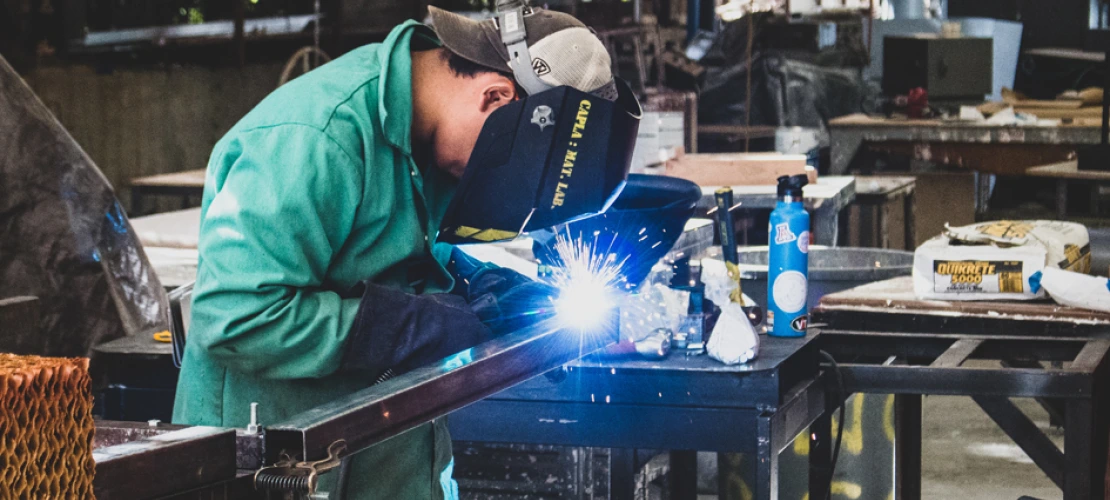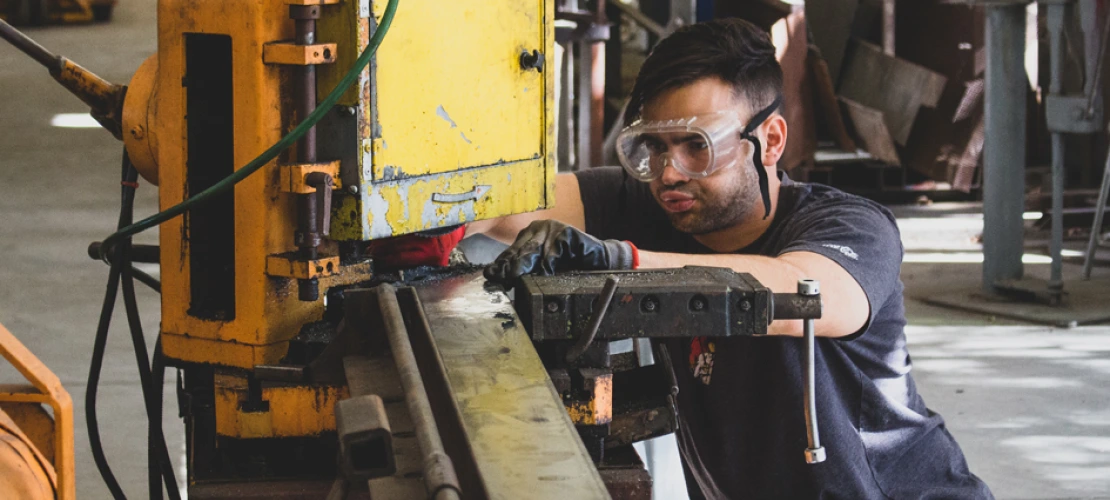Location: College of Architecture & Landscape Architecture East
The metal lab has an inside area for cold metal fabrication and an outside area (the covered deck) for hot metal fabrication including MIG, TIG, gas and Arc welding, plasma, grinding etc. We have tools for basic metal work cutting, bending, rolling, shearing, forging, and casting. Students must purchase their own materials for their projects.
Safety
Metal is always sharp and wants to cut you. It is always hot and it wants to burn you. Metalworking machines are always on and want to cut you. Repeat those three ideas to yourself every second that you are working with metal and you will prevent many injuries. Safety equipment is not optional. If you do not use it, you will get injured, and asked to leave the labs, hopefully before you are injured. Before using the Metal lab you must complete the metal orientation. You are not allowed to use the equipment in the welding area unless specifically trained and approved. Monitors will provide welding training to small groups. Arrange this with the metal lab monitors posted on the lab entrance and web site.
Personal Safety:
- You must be authorized to use the Metal Shop.
- Safety glasses must be worn at all times while in the Metal Shop. (Do not wear contact lenses.)
- Use the eyewash station if any foreign object gets in your eyes. They are mounted beside the sinks on the west side of the lab by the machining area and on the south wall sink by the CNC router in the wood area.
- Proper clothing must be worn. Synthetics like rayon can catch fire and melt. Also, no frayed edges or cuffs should be present. Proper footwear is mandatory.
- Always wear a full face grinding shield when grinding or sanding, in addition to wearing safety glasses, hearing protection is advised also, grinding metal is loud!
- No Jewelry should be worn in the Metal Shop (or anywhere in labs) (e.g. rings, bracelets, earrings, or necklaces. Metal sparks can adhere to jewelry and cause severe burns)
- Be aware of the location for the fire extinguishers. (Fire extinguishers mounted on south wall by roll up doors.)
Welding Safety:
- The welder is responsible for erecting a screen around the welding area to protect other students in the shop from injury.
- Always wear a welding shield of #10, minimum for MIG welding and # 4 or #5 for Oxy-fuel welding or cutting.
- Inspect all welding equipment to be used, prior to each use, for possible damage..
- Utilize all protective equipment and clothing. Do not arc weld with any part of the body uncovered, the arc light is actinic light (excessive ultraviolet) and will cause burns similar to severe sunburn.
- Always strap tanks to a welding cart or a fixed object. Never allow a gas cylinder to be free standing. Replace the safety cap on all cylinders when not in use.
- No skin should be exposed when welding so proper leather gloves, aprons, jackets, and appropriate shoes should be worn.
- When arc welding, make sure work and/or work table is properly grounded.
- Absolutely no jewelry is allowed to be worn. Do not arc weld in a wet area.
- Never pick up any metal without leather gloves or a pair of pliers (better so gloves do not burn). Metal may have been just cut or welded and may cause severe burns. Shut off the cylinder valves (righty tighty) when the job is completed, release pressure from the regulators by opening the torch valves momentarily and back out regulator adjusting valves.
- Weld only in approved areas, no welding inside!
- Allow for proper ventilation when doing any welding. All welding fumes are acidic and toxic, especially the fluxes in brazing or soldering.
- Do not weld on painted, galvanized or greasy, oily metals. Not only can the fumes be toxic, but the welds will not be satisfactory and will fail in use.
More information on general metalworking
Tools
- Vertical Band saws (18”, metal, mild steel only )
- Horizontal Band saw (12” round)
- Sheet metal Shear (4’ 16ga. mild steel)
- Power rolls (3’ x 3”rolls -¼” max)
- Sheet metal brake (4’- 16ga Inside) 6’-10ga. (outside on deck)
- Magna bend (4’ – 18ga)
- Di-acro former
- Baileigh metal roller (all profiles possible)
- Ironworker (shear, punch)
- 2 Drill presses (20”)
- Cold Saw (12”) (on deck)
- Belt sander (2”) (on deck)
- Grinder stationary
- 30 ton press
- MIG Welders (5)
- OXY/ACET welder
- Spot welder
- Arc/Stick Welder
- Plasma Cutting (2)
- Forging Furnace
- Speedy Melt (Casting aluminum)
- Sand Blaster


